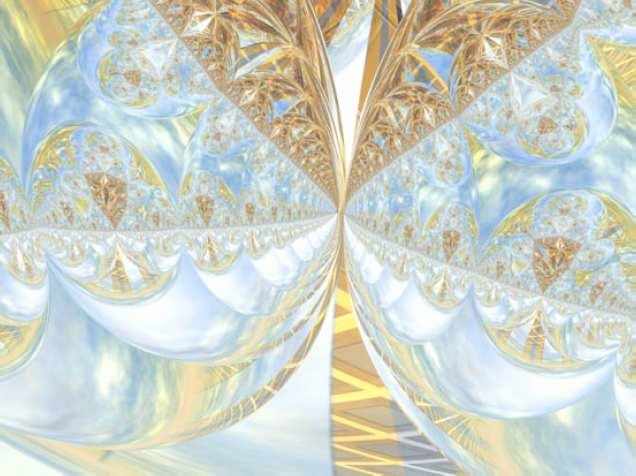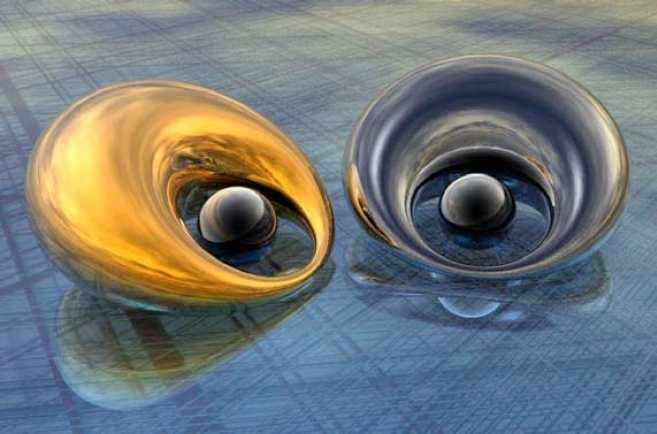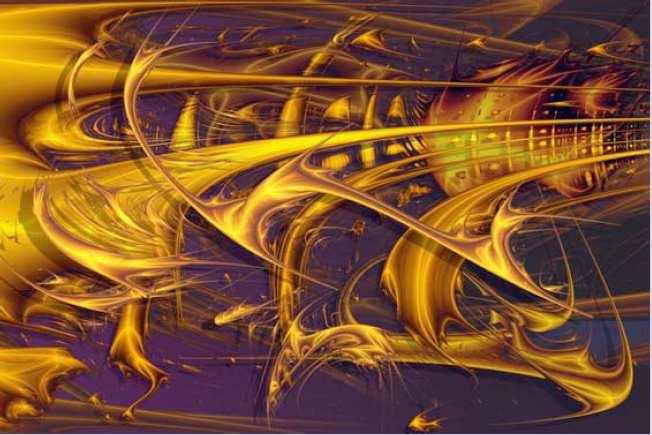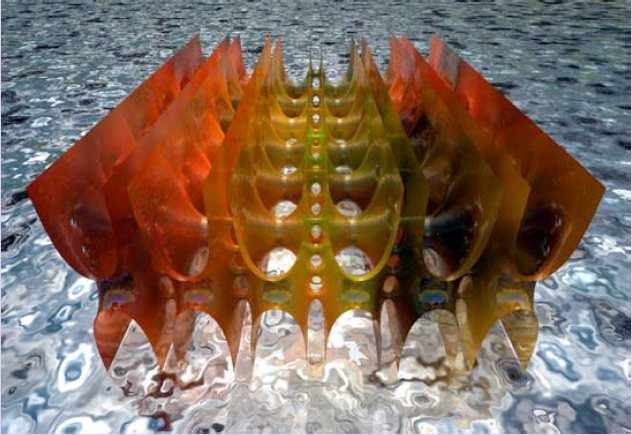by Richard S. Palais
Appreciation
In recent years it has become de rigueur for an invited speaker at a conference to “Thank the organizers for inviting me.” Today I can say this with more than the usual sincerity. Paris is my favorite city in the world, I have many fond memories of the Institut Henri Poincaré, and the subject of this conference is very close to my heart. So to Claude, and all the organizers who have worked hard to make this conference a success. Merci bien.
Introduction
Today I would like to tell you the story of perhaps the most enjoyable and stimulating collaboration of my career — my interaction with Luc Bénard. Luc is a talented creator of breathtaking mathematical art, and it really should be Luc standing here giving a talk at this conference, but unfortunately other commitments prevented him from coming to Paris at this time.
While I appreciate mathematical art, I have little talent for creating it, and what I brought to our partnership was primarily technical knowledge and experience in creating software tools for representing mathematical objects as computer-based images. True, Luc has made good use of these tools, but I feel somewhat embarrassed by the excess credit I have received for his creations; it is as if one gave partial credit for the Mona Lisa to the artisan who created da Vinci’s paintbrushes.
I looked back at my early email messaging with Luc recently. It shows that in early December of 2004, Luc was using my software, 3D-XplorMath (3DXM) and asked if it would be possible to save surfaces created with the program in a certain standard format (.obj), since that would make it possible for him to use other 3D graphics programs he liked a lot (Bryce and Carrara) to further process these surfaces. Since the Australian astrophysicist and computer scientist, Paul Bourke, was an expert in such matters (as well as having one of the best Mathematical Visualization websites on the Net) we asked him for help, and over the next few weeks Paul and I implemented saving 3DXM generated surfaces as .obj files with Luc as our beta-tester.
The five glass surfaces
The payoff came in the form of a spectacular New Year’s Day present from Luc!
From: Luc Benard ludev@videotron.ca
Date: January 1, 2005 10:26:07 AM EST (CA)
Subject: Re: surf format
Happy New Year to you and your family,
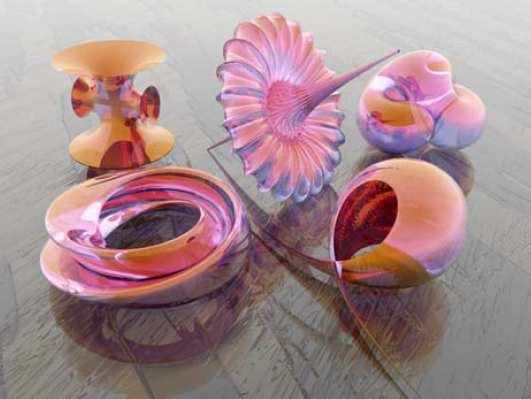
I couldn’t believe my eyes! The illusion of reality was so strong that I was completely convinced by it. I immediately recognized the surfaces as having originated from my own program, 3D-XplorMath, but I nevertheless believed that this had to be a photograph of real, physical glass models!
And I wasn’t the only one fooled by it. Here is a story I told to many people as I showed them Luc’s image — and most of them accepted it: These surfaces were initially created in software, using the mathematical visualization program called 3D-XplorMath. The resulting images were given to a highly skilled artisan glass-blower from Murano, who fabricated them out of thin colored glass. The glass objects were then given to a professional photographer who placed them artfully on a glass covered walnut tabletop and took their picture.
Of course, the virtual glass blower and virtual photographer were both Luc Bénard, from Montreal, not Murano. Here is my reply message to Luc. Note that I copied to many of my friends who are interested in mathematical visualization.
To:Luc Benard <ludev@videotron.ca>
Date: January 1, 2005 4:29:23 PM EST (CA)
Cc:Paul Bourke <paul.bourke@gmail.com>, dave hoffman <david@msri.org> karcher
<karcher@math.uni-bonn.de>, xah lee <xah@xahlee.org>, <matweber@indiana.edu>,
Martin Guest <martin@comp.metro-u.ac.jp>, eck@hws.edu
Dear Luc,
When I looked at your attachment I could hardly believe my eyes! My first impression was that this must surely be a careful high resolution digital photograph of real glass models sitting on a real glass tabletop and made by some incredibly skilled glassblower…
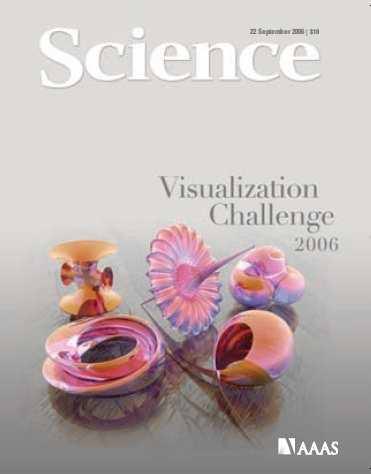
One of the people I sent Luc’s picture to was my daughter, Julie Palais, who is a program director for the US National Science Foundation. She liked the picture a lot and suggested that we submit it to the Science and Engineering Visualization Challenge, that each year is sponsored jointly by the NSF and Science Magazine. Luc and I decided to do that, although we felt we would be lucky to even get an honorable mention; Science Magazine is not very math oriented, tending to favour the “hard” sciences.
BUT, much to our surprise, we won First Prize in the 2006 competition, and Luc’s “Five Glass Surfaces on a Table Top” became the cover illustration of the Sept. 22, 2006 issue of Science.
Kuen’s surface
I will come back to the “Five Surfaces” later and show you a sample of all the very hard work that Luc put into producing the final image. But first let me tell you about another beautiful surface image that Luc created about a year ago. This one is of a single surface, the pseudospherical Kuen’s Surface, and it is intended to be more than just a pretty picture — as I will explain, it tells the story of a highly complex historical development that stretches from Euclid’s Axioms to modern Quantum Field Theory, and we decided to enter it into the 2009 Science and Engineering Visualization Competition.

For 2000 years mathematicians searched for a proof that Euclid’s other postulates logically implied his Fifth or Parallel Postulate: “Through a point outside a given line there can be drawn exactly one parallel line”. Finally, in 1826, Nikolai Lobachevsky showed that this was a futile goal; he constructed a geometry that satisfied the other Euclidean postulates, but not the Fifth. Indeed, in this new geometry there were infinitely many parallel lines through the given point. Such geometries are now sometimes called “Lobachevskian”, but more commonly are called “hyperbolic”, and surfaces in space that exhibit this geometry are called “pseudospherical”, after the simplest example, the Pseudosphere (which looks like two dunce caps held brim to brim). But just as in addition to the plane itself there are many “planar” surfaces in space, such as cones and cylinders, that obey Euclid’s axioms for plane geometry, so too there are many pseudospherical surfaces besides the Pseudosphere. A famous example, is Kuen’s Surface, that has been admired for its graceful beauty since its discovery 150 years ago.
One of their remarkable discoveries was that pseudospherical surfaces were in one-to-one correspondence with the solutions of a certain nonlinear partial differential equation that we now call the Sine-Gordon Equation. Usually such equations do not have explicit solutions, but Bäcklund discovered an important sequence of so- called soliton solutions that are explicit and which moreover correspond to particularly beautiful and symmetric pseudospherical surfaces. In fact, the Pseudosphere is a one-soliton surface and Kuen’s Surface is a two-soliton. A century later this same Sine-Gordon Equation mysteriously resurfaced in an entirely different context: it turned out to be a model of a Relativistic Quantum Field Theory, the kind of mathematical structure on which theoretical physicists base their most advanced and sophisticated theories of the structure of matter.
Our visualization captures some of the surprising mystery of this two-thousand year saga of intimately interconnected mathematical ideas. Our eyes perhaps dwell first on the planar objects: the floor with its two sets of parallel lines, the table-top and the piece of paper with its planar sketches of the Kuen Surface seen from various directions and an esoteric formula written below them. But though that formula lies in a plane, it is in fact the two-soliton solution of the Sine-Gordon Equation, and so describes the glassy Kuen Surface lying next to it, in whose pseudospherical shape we can see reflected the planar table top and scrap of paper with its images and its formula.
Fortune smiled on us again; the judges liked our visualization and the story behind it, and they awarded us another First Prize for the 2009 competition. Luc Bénard has produced a great many mathematical visualizations of various types, and I asked him recently which ones he liked the best. Let me show you a few of his favorites — accompanied by some of his artistic philosophy in his own words. Then, in what time remains, I will try to explain a little bit about Luc’s methods for creating these wonderful images.
Triply periodic surface WP
Because I love mathematic and I always find mathematical curves and surface graceful and really close to the curves and surfaces we find in the organic world I tried to use them as objects in 3D images simulating reality. Here is an example, The Triply Periodic Surface WP.
A fractal basin
Another example is the Fractal Basin: take four highly reflective tangent spheres with equal radii and centres at the vertices of a tetrahedron. You can use 3D software to replicate this reality, including some of it’s physical characteristics, including the reflection of light. if you look into the space between the sphere you see a fractal. Here it is with two zooms.
Two cyclides
Here is another one of Luc’s surface images — one of my favorites. It shows two glassy Cyclides side by side, each reflecting the other.
Tunnel 5B
This is a fantastic fractal!
Lya poster
This is another one of my favorites…



